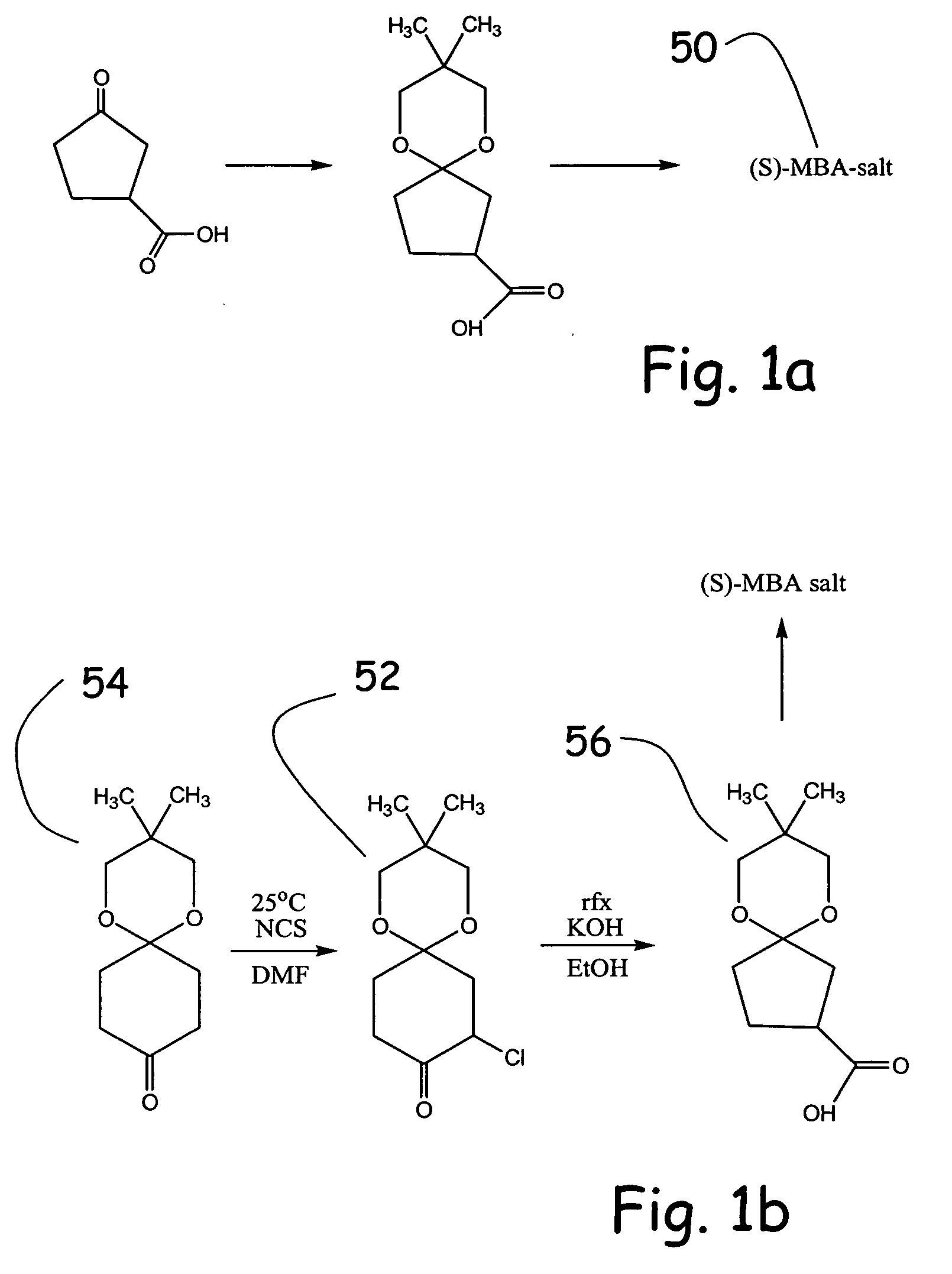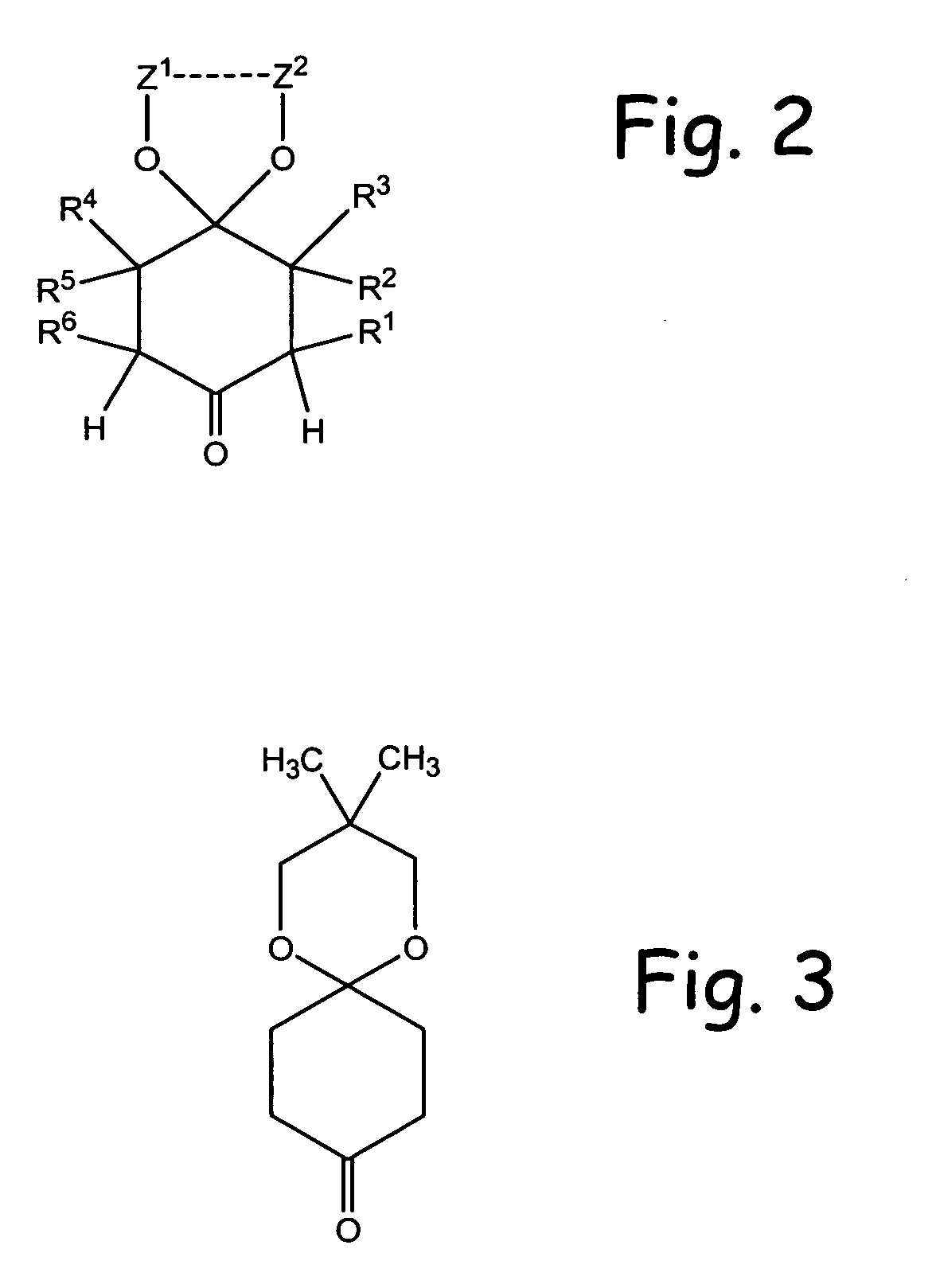Alpha functionalization of cyclic, ketalized ketones and products therefrom
a technology of ketalized ketones and cyclics, applied in the field of alpha functionalization of cyclic, ketalized ketones and products therefrom, can solve the problems of ketal moiety loss, waste, and the like, and achieve the effect of high selectivity and high yield
- Summary
- Abstract
- Description
- Claims
- Application Information
AI Technical Summary
Benefits of technology
Problems solved by technology
Method used
Image
Examples
example 1
3,3-Dimethyl-1,5-dioxaspiro[5.5]undecan-9-one
[0081] A continuous extraction apparatus is assembled. A 500 mL extraction solvent pot is charged with 250 mL n-hexane and 5.00 g sodium bicarbonate. An oil bath is heated to 90° C. A 500 mL reaction pot is charged with 82.5 g(0.792 mol, 2.33 equiv) neopentyl glycol, 338 mL H2O, 0.79 mL (1.45 g, 14.8 mmol, 4.35 mol %) of 98% sulfuric acid, and 38.08 g (0.340 mol) of 1,4-cyclohexanedione. n-Hexane (85 mL) is then added to bring the pot volume to the extractor return sidearm. The extraction pot is immediately immersed in the oil bath and the reaction mixture stir rate is increased to the point where there is efficient mixing in the lower (aqueous) phase but not in the upper (n-hexane) phase in the extractor. The extraction is continued for 99 h.
[0082] The suspension is cooled to 25° C. and the precipitate is suction filtered, washed with 50 mL n-hexane, and air dried 2 h at 25° C. to afford 10.71 g of crude bisketal as a colorless solid. ...
example 2
8,8-Dimethyl-6,10-dioxaspiro[4,5]decane-2-carboxylic acid
[0085] In a foil-covered flask, a solution of 1.000 g (5.04 mmol) of the monoketal of Example 1 and 0.674 g (5.04 mmol) of N-chlorosuccinimide in 1.0 mL dry DMF was stirred at 25° C. for 69 h. With the lab lights off, water (10 mL) was added and the mixture extracted with 5 mL MTBE five times. The combined MTBE extracts were dried (MgSO4), filtered, and concentrated in vacuo (rotary evaporator at 30° C. and 100 mm Hg then vacuum pump at 25° C. and 1 mm Hg for 30 min) to afford 1.135 g of crude chloroketone product as a pale yellow solid.
[0086] An ethanolic KOH solution was prepared by dissolving 1.14 g (17.3 mmol) of 85% KOH pellets in 5.0 mL anhydrous ethanol at 70° C. A solution of 1.135 g (˜4.88 mmol) of crude chloroketone in 7.0 mL of anhydrous ethanol was then added dropwise to the ethanolic KOH solution at 70° C. over 12 min. The resulting suspension was refluxed for 1 h (bath 80° C.)(dry N2).
[0087] The suspension was...
example 3
8,8-Dimethyl-6,10-dioxaspiro[4,5]decane-2-carboxylic acid
[0089] A mixture of 10.00 g (50.44 mmol) of the monoketal of Example 1,7.072 g (53.0 mmol, 1.05 equiv) of N-chlorosuccinimide, 581 mg 95.04 mmol, 10 mol%) of L-proline, and 50 mL isopropanol was stirred at −5° C. for 21.5 h to produce a suspension of crude chloroketone.
[0090] A solution of 15.02 g (227.6 mmol) of 85% potassium hydroxide in 60 mL anhydrous ethanol was prepared at 70° C. The suspension of crude chloroketone was then added via Teflon cannula over 20 min at 70° C. The resulting suspension was refluxed (bath 80° C.) for 1 h.
[0091] The suspension was cooled and solvents removed on a rotary evaporator at 30° C. and 50-40 mm Hg. The residue was taken up in 50 mL H2O, washed with 50 mL toluene twice, and washed with 25 mL MTBE three times. The suspension was then added to 300 mg of 18 wt % palladium hydroxide on carbon and the suspension hydrogenated at 25° C. and 36-32 psi H2 for 17 h. The catalyst was removed by f...
PUM
| Property | Measurement | Unit |
|---|---|---|
| temperature | aaaaa | aaaaa |
| temperature | aaaaa | aaaaa |
| temperature | aaaaa | aaaaa |
Abstract
Description
Claims
Application Information
 Login to View More
Login to View More - R&D
- Intellectual Property
- Life Sciences
- Materials
- Tech Scout
- Unparalleled Data Quality
- Higher Quality Content
- 60% Fewer Hallucinations
Browse by: Latest US Patents, China's latest patents, Technical Efficacy Thesaurus, Application Domain, Technology Topic, Popular Technical Reports.
© 2025 PatSnap. All rights reserved.Legal|Privacy policy|Modern Slavery Act Transparency Statement|Sitemap|About US| Contact US: help@patsnap.com



